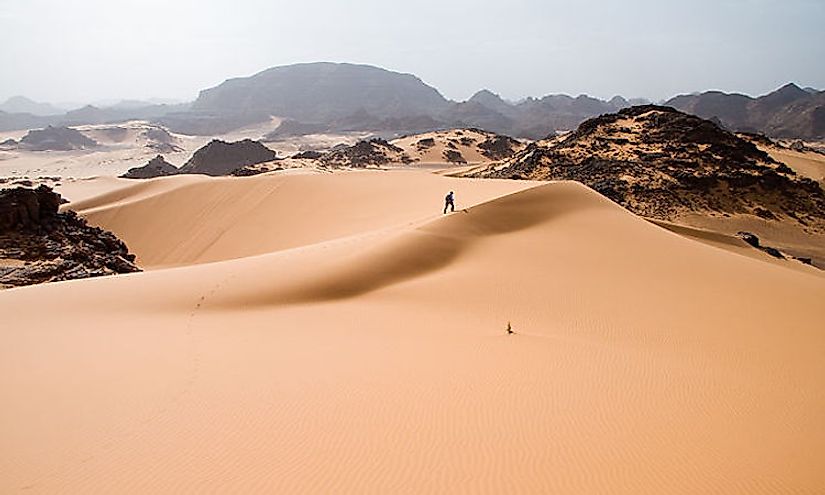Ecological Regions Of Libya

Libya is a North African country located near the Mediterranean Sea that borders Egypt, Tunisia, Chad, Niger, Sudan, and Algeria. The country has two major climatic zones including the Mediterranean along the coast and dry deserts in the interior. Most of the country is in the Sahara region. Libya receives little rainfall and has a limited area that supports agriculture as most parts of the country is dry. The major activities here are pastoralism and oil drilling. Libya has different ecological regions within the country. These ecological regions have different climatic conditions providing a home to a variety of flora and fauna.
Ecological Regions Of Libya
Dry Sahel
The dry Sahel ecoregion is within the fresh-water biome and has an arid climate with sections of freshwater pockets. These fresh water zones are home to a variety of fish species that are adapted to surviving in harsh conditions of the Sahel. Some of these species hibernate or rest for some time to avoid desiccation in extreme conditions. These species include crustaceans, aquatic insects, amphibians, fish, and mollusks. The main threat to this ecoregion is the fast-spreading desert.
The Gulf of Sidra
The Gulf of Sidra ecoregion is a marine biome found on the Mediterranean coast of northern Libya. Mediterranean climate is predominant in the Gulf with rainfall during winter. The Gulf is characterized by saline clayey soils. The Gulf supports a wide diversity of marine organisms including sharks, rays, shorebirds, and sea turtles. The Gulf is an important fishing ground for the people around the area. Overfishing and oil pollution have led to the destruction of the marine eco-region. The IUCN has called for the sustainable use of the marine eco-system to conserve the fragile environment by both local communities and the government.
Levantine Sea
The Levantine Sea is in the eastern part of the Mediterranean Sea to the north of Libya. The marine biome connects to the red sea via the Suez Canal. The climate experienced here is Mediterranean with warm summers and mild winters with scanty rainfall that occurs during winter. Due to the flow of surface water from the red sea and reduced inflow from the Nile, the salinity of the Levantine Sea has increased leading to migration of species from the Red Sea to the Nile while the native species in the Levantine die out. Species in the Levantine include dolphins, sea turtles, Mediterranean monk seal, the red millet, and the flounder. Overfishing and salinization are the biggest problems in the eco-region.
Mediterranean Dry Woodlands And Steppe
In Libya, the ecoregion lies in two distinct sections located on the opposite sides of the Gulf of Sidra. The ecoregion experiences an arid climate with annual precipitation of 100-300mm. Rainfall is received mainly during winter accompanied by storms. The average annual temperatures are about 18ºC. Biodiversity in the region includes steppe grasslands, forests, shrubs, and endemic vertebrates such as mammals, reptiles, birds, and amphibians. Some of the endemic mammals include the Barbary sheep, mountain gazelles, and the stripped hyena. Threats to the ecoregion are mainly habitat destruction through deforestation and human activities. Some of the protected areas such as Karabolli National Park, Bier Ayyad Nature Reserve, and Nefhusa have been established for the conservation of the region.
The Environment Of Libya
Libya is mainly composed of dry areas with limited rainfall and lacks permanent water sources. The prevailing climatic conditions in the country are arid with limited rainfall and poor soils that do not support agriculture. Such conditions make the population rely heavily on fishing and pastoralism. Other significant ecoregions in the country include Mediterranean woodland and forests, northern Saharan steppe and woodlands, temporary and permanent Maghreb, Sahara desert and halophytic, and Tibetsi-Jabel Uweinat montane xeric woodlands.
Ecological Regions Of Libya
| Ecological Regions of Libya | Biome |
| Dry Sahel | Freshwater |
| Gulf of Sidra | Marine |
| Levantine Sea | Marine |
| Mediterranean dry woodlands and steppe | Mediterranean Forests, Woodlands, and Scrub |
| Mediterranean woodlands and forests | Mediterranean Forests, Woodlands, and Scrub |
| North Saharan steppe and woodlands | Deserts and Xeric Shrublands |
| Permanent Maghreb | Freshwater |
| Sahara Desert | Deserts and Xeric Shrublands |
| Saharan halophytics | Flooded Grasslands and Savannas |
| Temporary Maghreb | Freshwater |
| Tibesti-Jebel Uweinat montane xeric woodlands | Deserts and Xeric Shrublands |











